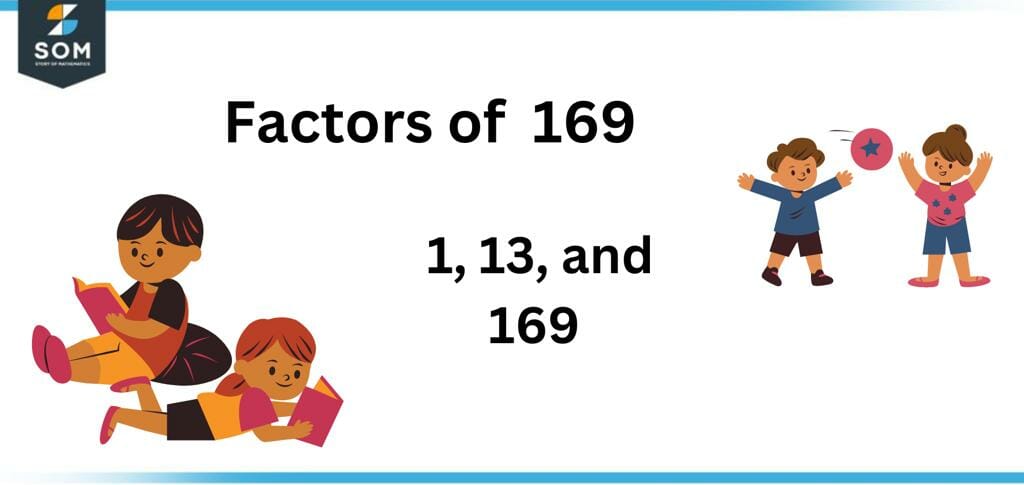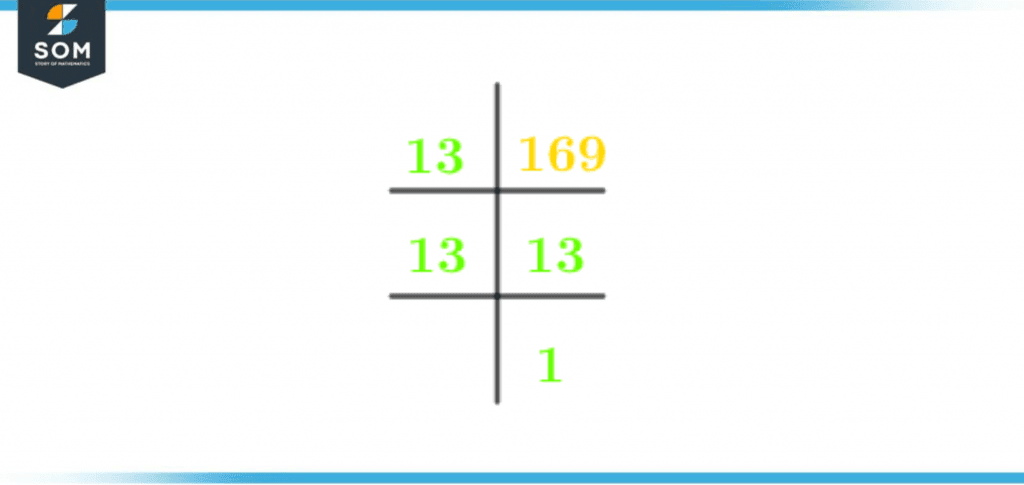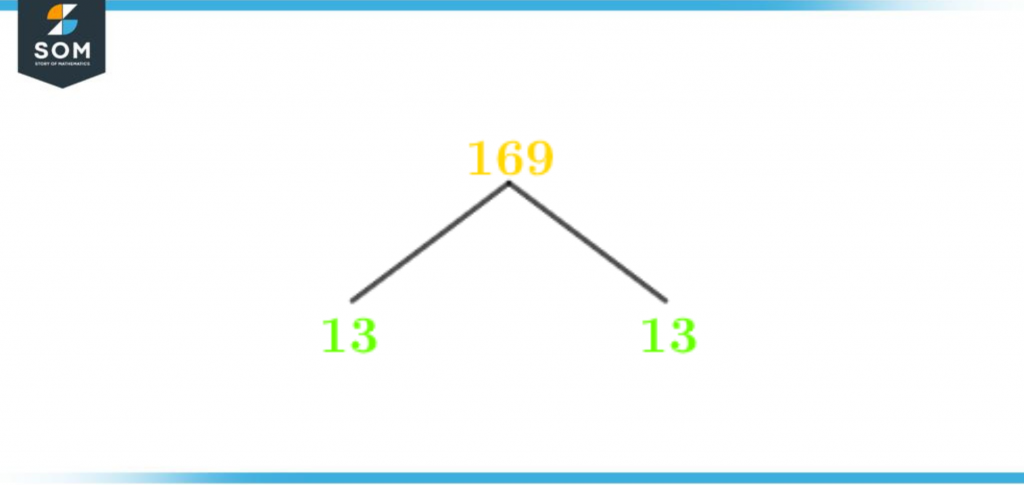JUMP TO TOPIC
Factors of 169: Prime Factorization, Methods, Tree, and Examples
Factors of 169 are the numbers that perfectly divide 169 without leaving any remainder behind. Factors of 169 are also the numbers that produce the actual number when multiplied.
Figure 1 – All possible Factors of 169
What Are the Factors of 169?
Factors of 169 are 1, 13, and 169. When 169 is divided by any of these numbers, they give zero as the remainder. 169 is an odd composite number. A whole number having factors other than the number 1 and itself is known as a composite number. That indicates 169 has more than two factors.How To Calculate the Factors of 169?
You can calculate the factors of 169 by division method and prime factorization. We will learn both methods in this article.To find the factors of a given integer, first of all, we have to find the region in which factors of 169 will lie. For better understanding, draw a number line. Mark the starting point as 1 and the ending point of the number line as 169. The factors will lie on this number line.Finding factors of 169 by division method:Always start the division by the smallest number on the number line or you can say the starting number of a number line.Our number line starts from 1, so the first divisor for 169 will be the number 1.\[ \frac{169}{1} = 169 \]\[ \frac{169}{-1} = -169 \]One is a factor of every whole number because every number is perfectly divided by 1. The above division indicates that zero is obtained as a remainder.The number 1 and -1 are factors of 169.All even numbers are evenly divisible by 2. The number 169 is not even, so it wouldn’t be perfectly divisible by 2.Let’s divide 169 by 3:\[ \frac{169}{3} = 56.33 \]When we divide 169 by 3, the number is not perfectly divided. The remainder is not zero, and the quotient is in decimal form. When a number is divided by 169 and the quotient results in a fractional or decimal form, that number does not qualify to be a factor of 169.Divide 169 by 13:\[ \frac{169}{13} = 13 \]\[ \frac{169}{-13} = -13 \]When 169 is divided by 13, the number is evenly divided and the remainder is 0. The numbers 13 and -13 qualify to be a factor of 169.Lastly, let’s divide 169 by itself:\[ \frac{169}{169} = 1 \]\[ \frac{169}{-169} = -1 \]Every integer is a factor in itself. As every number is perfectly divisible by itself and the remainder is zero in every case. 169 and -169 are the factors of 169.The list of positive factors of 169 is 1, 13, and 169. The list of negative factors of 169 is -1, -13, and -169.Factors of 169 by Prime Factorization
Prime factorization is a mathematical technique by which we determine the prime factors of a number. By using prime factorization, we can represent a number as a product of its prime factors.The composite numbers can only be expressed by using prime factorization. Prime factorization is done by simple division.Before getting into this, list the prime factors of 169.List of prime factors of 169: 13The number 169 has only one prime factor.Prime factorization begins with dividing the given number by its smallest prime factor. In this case, we have only one prime factor, so divide 169 by 13.\[ \frac{169}{13} = 13 \]We carry out the division until we obtain 1, so again divide it by 13.\[ \frac{13}{13} = 1 \]The Prime Factorization of 169 is shown below in figure 2:
Figure 2 – Prime Factorization of 169
Factor Tree of 169
A factor tree can be defined as a special diagram that helps decompose a mathematical number into all its prime factors. This is one of the easiest ways to find the prime factors of a given number. The factor tree of 169 is shown below in figure 3:
Figure 3 – Factor Tree of 169
Factors of 169 in Pairs
A simple mathematical definition of a factor pair is a set of two integers that when multiplied, yield a particular product that is equal to the given number.So 169 pair coefficients are multiplied and the product is 169. Factor pairs can be positive or negative. For positive factors:1 x 169 = 169
13 x 13 = 169
So the positive pair coefficients are 1, 169 and 13, 13.The positive factor pairs of 169 are the following:(1, 169)
(13, 13)
For negative factors:As you know, multiplying two negative numbers gives a positive number. This is because the negative sign of one cancels out the other.-1 x -169 = 169
-13 x -13 = 169
The negative pair coefficients are -1, -169, and -13, -13.The negative factor pairs of 169 are the following:(-1, -169)
(-13, -13)
Factors of 169 Solved Examples
To further strengthen your concepts, let’s have look at some solved examples of factors of 169.Example 1
Sophia bought 13 cakes for her birthday party. She paid 169 dollars for 13 cakes. Help her find the price of each cake.Solution
Total cakes Sophia bought: 13 cakes.The total price of 13 cakes: 169 dollars.To find the price of each cake, we will divide the total price by the total number of cakes.Finding the price of each cake:\[ \frac{169}{13} = 13 \]By the above calculation, Sophia concluded that each cake costs 13 dollars.Example 2
Find the common factors of 169 and 338.Solution
To find common factors of 169 and 338, first list the factors list of both numbers.List of factors of 169: 1, 13, 169.List of factors of 338: 1, 2, 13, 26, 169, 338.Common factors are a list of factors that are common in the above factors lists of 169 and 338.Common factors of 169 and 338: 1, 13, 169Example 3
Isabella is making identical balloon arrangements for a birthday party. She has 13 pink balloons, 104 white balloons, and 169 orange balloons. She wants each arrangement to have the same number of balloons of each color. What is the greatest number of arrangements that Isabella can make if every balloon is used?Solution
First, find the factors of 13, 56, and 169.Factors list of 13: 1, and 13.Factors list of 104: 1, 2, 4, 8, 13, 26, 52, and 104.Factors list of 169: 1, 13, and 169.Now find the greatest common factors among the above three factors lists.The greatest common factor of 13, 104, and 169 is: 13The arrangement that Isabella can make if every balloon is used is 13.Example 4
There are 169 girls and 117 boys who want to participate in the 6th-grade competition. If each team has the same number of girls and boys,- What is the greatest number of teams that can participate in the competition?
- How many girls and boys will be in each team?
